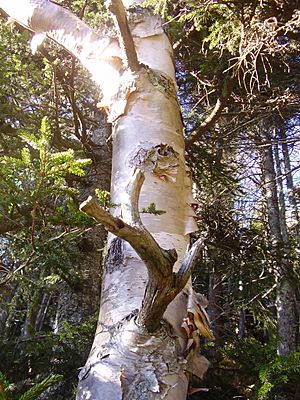Mountain paper birch facts for kids
Quick facts for kids Mountain paper birch |
|
|---|---|
 |
|
| Conservation status | |
| Scientific classification | |
| Genus: |
Betula
|
| Species: |
cordifolia
|
| Synonyms | |
|
|
The mountain paper birch, also called mountain white birch or eastern paper birch, is a type of birch tree. Its scientific name is Betula cordifolia. This tree grows naturally in Eastern Canada and the Northeastern United States. For a long time, people thought it was just a kind of Betula papyrifera, which is the paper birch. They look very similar!
Contents
What Does the Mountain Paper Birch Look Like?
The mountain paper birch is a deciduous tree. This means it loses its leaves every autumn. These trees can grow very tall, up to about 25 meters (82 feet). Their trunks can be quite wide, around 70 centimeters (28 inches) across.
Bark and Leaves
The bark of a grown mountain paper birch is usually white or bronze-white. It peels off in thin layers, which is a cool feature! The inside of the bark looks like copper. When the tree is young, its bark is shiny brown. It has small, pale brown marks called lenticels. These lenticels help the tree breathe.
The leaves of this birch tree grow in an alternating pattern along the branch. They are shaped like an oval and are about 6 to 12 centimeters (2.4 to 4.7 inches) long. Each leaf has a double-toothed edge, meaning it has small teeth along the edge, and those teeth have even smaller teeth!
A special thing about these leaves is their shape at the bottom. The scientific name cordifolia means "heart-shaped leaf." Most of the time, the base of the leaf is shaped like a heart. However, sometimes it can be flat or rounded instead. The leaves also have many tiny resin glands on them.
Twigs and Flowers
The small branches, called twigs, are yellow-brown to dark-brown. They also have resin glands and gray lenticels. Unlike some other birch trees, the twigs of Betula cordifolia do not have hairs.
The flowers of the mountain paper birch are called catkins. These look like long, hanging clusters. The catkins that produce pollen are about 2 to 4 centimeters (0.8 to 1.6 inches) long. The catkins that produce seeds are smaller, about 1 to 2 centimeters (0.4 to 0.8 inches) long. When the seed catkins are fully grown, they are about 3 to 5 centimeters (1.2 to 2 inches) long. They hold small, winged nutlets that are about 2 to 3 millimeters (0.08 to 0.12 inches) long. These nutlets are the tree's seeds.
Where Does the Mountain Paper Birch Grow?
You can find Betula cordifolia in Atlantic Canada, Quebec, and the northwestern part of Ontario. It also grows in the Northern part of New York State and throughout New England in the United States.
This tree usually lives in northern areas or high up in the mountains. It especially likes moist ground, so you might find it near streams or in damp forests.
How Is It Different from Paper Birch?
The mountain paper birch (Betula cordifolia) and the paper birch (Betula papyrifera) look very much alike. For a long time, scientists thought they were the same species! But there are a few key ways to tell them apart:
- The mountain paper birch only grows in the eastern part of North America.
- Its leaves have tiny resin glands on them.
- The base of its leaves is often heart-shaped.
- The young shoots (new twigs) of Betula cordifolia do not have hairs.
- It usually has a different number of chromosomes (28 chromosomes, which is called diploid).
Since some of these features can vary, it's best to look for several of them to be sure which tree you are seeing. Scientists used to think these two birches might mix and create hybrid trees. However, newer studies looking at their chromosomes suggest this is unlikely. The most certain way to tell them apart is by checking their chromosomes.


